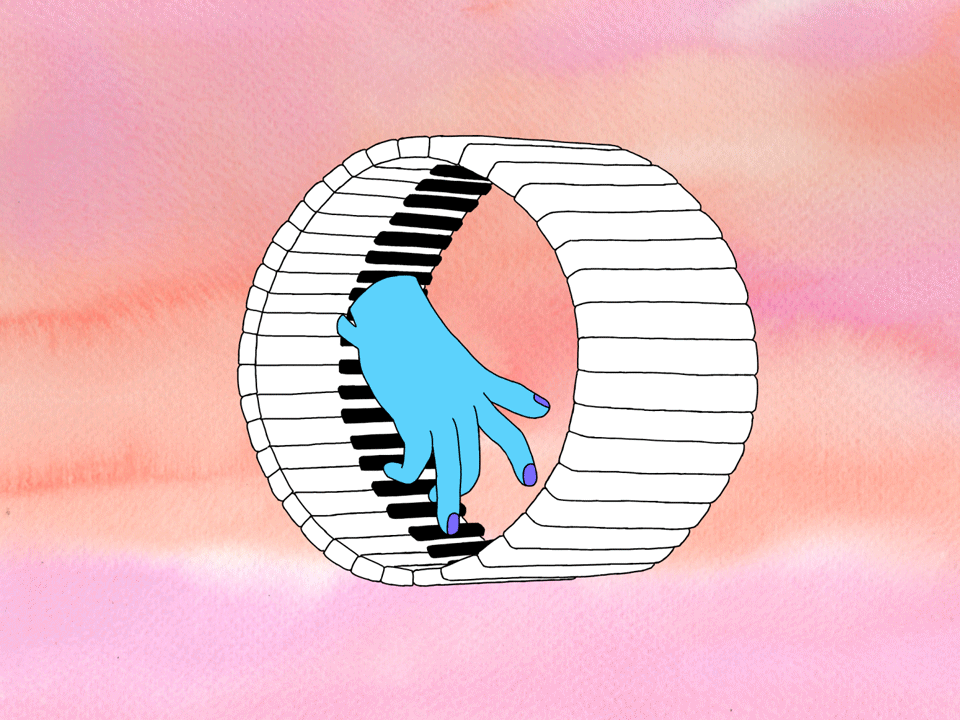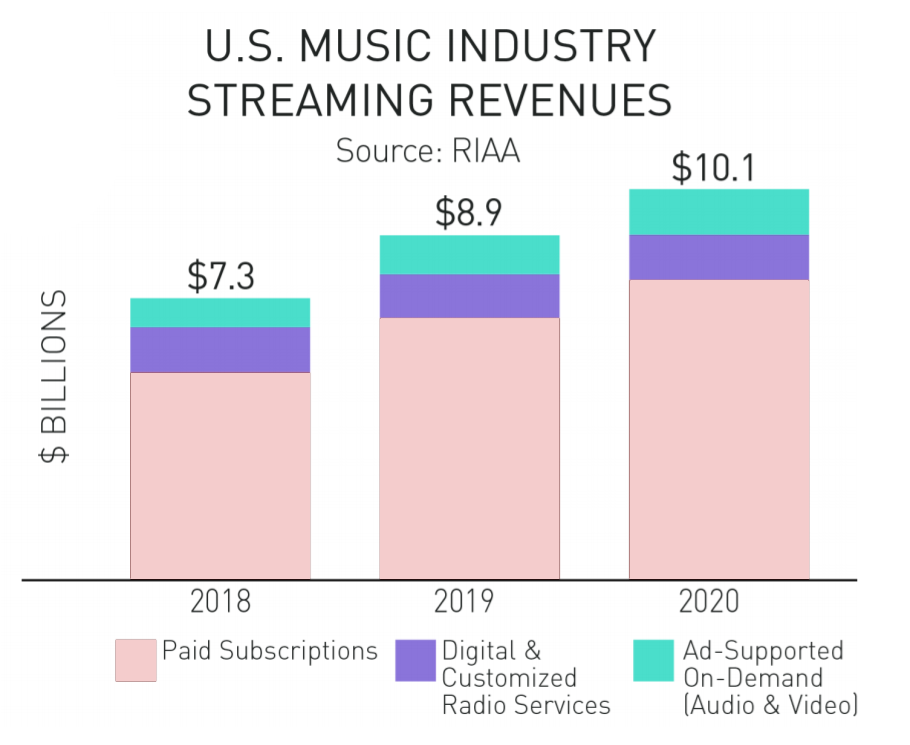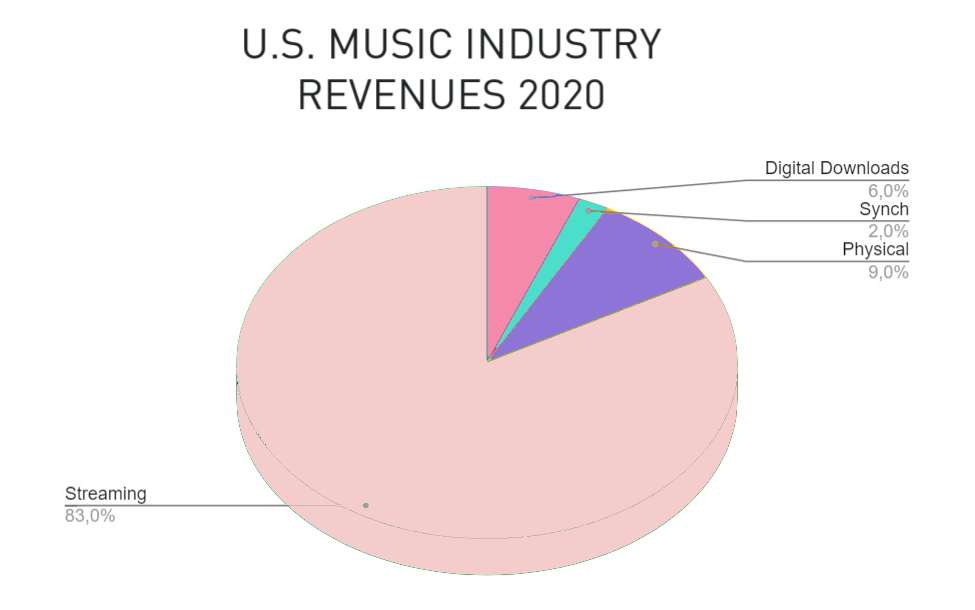Follow-up article on ‘Blockchain in the Music Industry: Signs of the New Paradigm?’ (2019)
Originally published in Paradigm blog.

The pandemic affected many industries, and the music industry was no exception: retail store closures, tour cancellations, and venues closing their doors, and the list goes on. You simply couldn’t just go out and buy a record at your local store. Live shows began to seem to be something supernatural, or tales of a long-forgotten time. Concerts which were previously one of the main sources of income for musicians are now almost nowhere to be seen (apart from e.g. a unique pair of the Flaming Lips gigs, where both the band and their audience were inside individual inflatable balls — as means of defending against the virus, which was one of the few exceptions that prove the trend).
Astoundingly, even so, the industry manages to grow and thrive by finding other ways to survive.

In 2020, in the USA, overall recorded music revenue increased by more than 9% to $12.2 billion [According to the RIAA’s annual year-end report]. That growth was primarily sustained by more money coming from streaming services generating $10.1 billion in revenue in 2020 — up from $8.9 billion in 2019. 2020 marked the sixth consecutive year of this subsector growth that had previously struggled with declining revenues for 15 years.

Of the major streaming platforms, expectedly Spotify and Apple Music were the biggest contributors, generating $7 billion in revenue. Concurrently, the average number of subscriptions in 2020 increased to 75.5 million — up from 60.4 million. [Check out ‘The Best Online Music Streaming Services for 2021’ by PC Magazine to compare the platforms].

When you put all those numbers together, in the previous year, music streaming, both subscription-based and ad-supported, accounted for 83% of the industry’s total revenue — up from just 7% in 2010.
It is known that the music industry has always been dominated by gatekeepers. The invention of the internet, Napster digital revolution, creation, and spread of streaming platforms such as Soundcloud and now Spotify have changed the landscape drastically. However, while it is becoming more and more momentous to talk about streaming as a phenomenon, these platforms’ users are starting to express more and more concerns about where all these billions earned from auditions go to. Sad to say, the major streaming platforms still leave only small percentages to the musicians themselves, their model is long ago established — payout generously to the world’s most famous artists. Therefore, it is still difficult for small and independent ones to make a living off their music.
The statistics spoke for themselves: in 2020, the top 500 artists on Spotify generated around $1.85 billion in royalties from the streaming service — 37% of its overall payouts, while the 286,000 DIY musicians releasing through distributors generated $1.17 billion of Spotify royalties last year — around 23.5% of the total [according to the Spotify’s new website Loud & Clear, launched in March 2021].
Some platforms have tried to address this problem, e.g. Bandcamp launched ‘Bandcamp Friday’ initiative in the previous year, and every first Friday of the month, the company waived all of its commission fees, meaning more of the users’ money goes directly to people who created it. What’s more, SoundCloud’s new user-centric royalty system will revolutionize streaming for the music industry. Starting April 1st, 2021, the platform will pay artists and indie rights holders based on their number of listeners, not stream counts.
Apparently, this is just a drop in the bucket, this is not enough. Decentralized music platforms should come to the rescue here.
“I think we’re going into a post-Spotify earning era — I’m calling it the digital artist monetisation era. When you look at Audius, UCPS, Patreon, Twitch, in-stream tip jars: this is going to impact artists a lot.”
— Marc Geiger, WME music chief at SXSW 2021’s online conference, March 2021
DLTs and blockchain seem to be the next step when it comes to giving power back to creators and their listeners.
In a nutshell, the main and most visible DLT solutions for the music industry are as follows:
- The ability to remove middlemen from the process of music sales and streaming. Thus, payment of inclusive royalties that divide revenues fairly according to each person’s contribution to the creative process can be executed automatically. While the skewed distribution is unlikely to be fully addressable, improving conditions for emerging artists can lead to a more diverse market.
- A digital rights database. Rich distributed databases can be implemented so that everyone can interact with each other and associate the underlying copyrighted material with all their metadata in the digital ledger for all to see.
- Tokenized rights management which means the deployment of smart contracts that actually manage rights and maximize the value of publishing, recording, performance, merchandise, and all other artists’ rights. This includes terms and conditions of third-party engagement for record labels and distribution services.
- Complete transparency and data protection. Transparent ledgers are distributed hence everyone can see how much revenue a song brings, the timing and magnitude of the revenue streams, and who and what percentage received.
- New revenue sources for artists. It’s all about NFTs and crowdfunding. Music creators can earn from users via selling non-fungible tokens. There can also be an auction dynamic pricing mechanisms to experiment with promotions and versioning of content.
- Monetary incentives for listeners. DLT music platforms can make the whole music experience more interactive and rewarding for the fans. They can reward users not only through exclusive content and lower prices. Some of them offer listeners rewards for curating personalized playlists (like Choon did), some reward fans with its native tokens for contributing to the database of artists, venues and events (Viberate, and others).
Two years ago, I briefly overviewed the music industry’s 2019 state by describing ≈30 blockchain projects, which had the potential to boost it. To this day, some of them succeed and flourished, but many already ceased to exist without making a proper product. Such promising services as Choon, which paid artists on a daily basis 13 times more for streams than Spotify, or Feedbands, whose team planted 1 tree for every 100 streams, just disappeared.


Luckily, the industry does not stand still, and new initiatives constantly appear.
- Last week, the Async Art team dropped Async Music which is composed of a single Master Track NFT and multiple Stem NFTs. Just like a programmable artwork, Stem NFTS are effectively the same as Layer NFTs: they have the ability to change what the current Master Track both looks AND sounds like.
- In February, Treum, a ConsenSys Mesh portfolio company, created an EulerBeats project, which is 27 algorithmically generated art and music NFTs. Worth mentioning, in 2020, ConsenSys was selected by the Mechanical Licensing Collective (MLC), with the Harry Fox Agency, to modernize music royalties data and payments over the next several years. The MLC portal, largely built by ConsenSys, launched in January and is still evolving.
- On new NFT Foundation platform, a creative playground for artists, curators and collectors, you can mint your audios as well as artworks.
- At the end of 2020, Zora appeared — a new NFT platform for creators of all types. Each artist that mints audio NFTs on the platform can set a “creator share” which is a percentage that they will receive for all future sales. In February 2021, Linkin Park’s Mike Shinoda sold a digital piece of art for $30,000 on it, which he intends to donate to charity. On March 10th, Catalog platform built on the Zora Protocol went live. Now artists can mint their music as 1/1 NFTs, making them free to listen for everyone and individually ownable by collectors.
OMG, WTF, NFTs?
Moreover, many well-known labels and artists finally begin to notice the potential of the technology, finding additional sources of revenue in the pandemic times, when there is no chance to book a tour and all that jazz, they unintentionally nobly spread information bringing adoption closer every day.
Thus, Warner Music Group invested in Dapper Labs — the company behind CryptoKitties, and as part of its partnership with WMG, the startup has teamed with Muse to create two crypto-collectibles, including a limited edition Kitty ‘signed’ by the band.
In early March, Kings of Leon became the first band to announce the release of an NFT album, with three types of tokens that include special artwork and perks. Daft Punk issued several collectibles on the Rarible platform before announcing they broke up. Electronic music producer 3LAU sold 33 NFTs for a total of $11,6 million which included a platinum-plated vinyl record redeemable for a custom song by the artist as well as access to unreleased music and a bonus physical vinyl disc, through a collaboration between his team and Origin protocol, a crypto-trading company that helps develop marketplaces on the Ethereum blockchain. Recently, Grammy Award-winning artist RAC announced plans to launch an NFT creative agency.
A few days ago, Elon Musk, the ‘Technoking’ of Tesla, had tweeted a techno song about NFTs which repeats “NFT” over and over, eventually getting to the female-sung lyrics:
“NFT for your vanity, computers never sleep, it’s verified, it’s guaranteed.”
Earlier, Elon’s girlfriend Grimes sold 10 art NFTs pieces on the art trading platform Nifty Gateway for $5.8 million in just 20 minutes.
This NFT madness reaches that absurd point that today when opened the news I’ve read about a Brooklyn-based film director who is simultaneously mocking and attempting to profit off the NFTs by selling on OpenSea platform a year’s worth of fart audio clips recorded in quarantine. The bid for one file is currently 0,5ETH. Hah. More indie/arriere-garde music to masses!
Almost all of these events are marked by 2021. And undoubtedly this is just the beginning.
Keeping in mind all the solutions the DLTs and blockchain can offer, following this hype and wide adoption of NFTs and accretion of open art trading platforms itself, a small breakthrough is needed in a long-expected understanding that the music industry is capable of honesty towards musicians, transparency, and hence even more impressive prosperity that it has shown in 2020.
__________________________
*Direct-to-fan (D2F) is a business model used by independent musicians, promoters, and others in the music industry, which bypasses the major record label model that historically controlled radio, venue, and distribution channels, and lets the artist create interest in their music directly with their fans, develop relationships with them, and monetize those relationships.

Me on Twitter, LinkedIn, Raribe, Zora ✨
Check out our new platform 👉 https://thecapital.io/
https://twitter.com/thecapital_io
https://medium.com/media/3b6b127891c5c8711ad105e61d6cc81f/href
DLT and Blockchain in the 2021 Music Industry: State of the Art was originally published in The Capital on Medium, where people are continuing the conversation by highlighting and responding to this story.